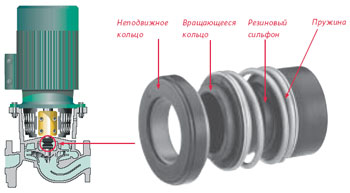An Introduction of Mechanical Seal
An Introduction of Mechanical Seal
Mechanical seal is the most advanced and effective packing for the rotating pump shafts.
Mechanical seals are designed to prevent a leakage of the pumped liquids, serious accidents are excluded. Sealing is ensured by the tight fit of two components - rotating and stationary - along the sealing surface.
Qualitative mechanical seal gives noticeable reduction of the power consumption of the pumping facilities and systems.
Friction pair is a crucial factor. Mechanical seals are mostly made of silicon carbide – ceramics, silicon carbide – silicon carbide, other high-quality materials are also used.

Mechanical Seals
In today's industrial environment, the purpose and usage scenario of Mechanical Seal and accessories are growing. Environmental contamination has been a growing concern in china and world for decades, and in each of those decades the Environmental protection agency (EPA) has made the allowed leakage of environmental contaminants increasingly strict. Mechanical Seals have played a large part in reducing the emission once only slowed by braided packing which had to leak to function. Mechanical Seals have become a standard for Refineries, Chemical plants, waste water plants, Ships, and other critical leakage control industries, as well as applications applicable to the everyday consumer including automobile water pumps, and swimming pool pumps. They offer exceptional leakage control, and have increasingly replaced braided packing. Usage of mechanical seals will only expand as environmental hazards in developing nations become larger issues and need to be addressed. Mechanical Seals life spans vary according the demands of the applications. While a typical (current day) automotive mechanical seal will last 100,000 miles (over 8 years on average), a seal with the wrong seal face combination or secondary seal and fail in hours or even minutes. Common seal failure include:
· 1. Abrasives: Many applications can attack a seal by being abrasive thereby prematurely wearing the seal faces away.
· 2. Speed: By being to fast for the seal, causing excessive wear on the seal faces, as well as causing excessive heat which usually attacks (or melts) the secondary seals (often o-rings), permitting leakage through those passages being sealed
· 3. Chemical attack. If not selected properly, secondary seals such as o-rings, rubber boots, and rubber gaskets, can be attacked and eventually give way. Not only do the daily media being sealed must be concerned, but also any flush fluids used in keeping systems clean must be considered.
· 4. System Shock, water hammer, and vibration, can all have detrimental effects on seals, particularly seal faces, especially seal faces such as carbon (the most common) Silicon Carbide and Ceramic are all prone to cracking, fracturing and breakage when subjected to vibration (often caused by failing bearings), system shock and water hammer. The cause of the failure is often the least obvious and can appear to be the result of an inferior seal. The seal, will need to be adapted to withstand system shock, water hammer and vibration by utilizing "hard faces" such as Tungsten carbide.
A Mechanical Seal has 3 primary design characteristics
- Seal Faces - which are lapped flat to within 2 - 3 light bands. Making the seal face flat within millionths of an inch. Since both faces are lapped flat and then pressed together it effectively seals our any fluid (other than a very thin film) from leaking between them.
- An Energizer - It's done using a single spring, multiple springs, wave springs, metal bellows or even o-rings or internal pressure, but one of the above must be used to create a force pressing seal faces together preventing leakage from between the seal faces.
Secondary Seals - While seal faces seal perpendicular to the shaft, secondary seals are necessary to seal parallel to the shaft. Those seals include rubber boots, common to industry standard type 1, 2, 21, 6 and 6A seals. O-Rings made of a variety of elastomers including Buna-N, Viton, Aflas, Kalrez, Chemrez, Amerirez, PTFE, SBR, Neoprene, and FEP encapsulated o-rings. Gaskets made or the same elastomers as above, along with Flexible Graphite, and Compressed non-asbestos materials. In the case of high temperature metal bellows seals Flexible Graphite wedges are used to seal the pump sleeve/shaft.
